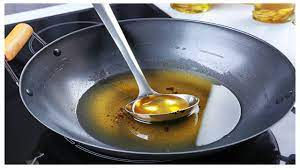
Introduction:
In the culinary world, the sizzle and aroma of frying food are an art form, but behind the scenes lies a critical aspect that often goes unnoticed – the proper handling and disposal of used cooking oil (UCO). Understanding the secrets of extending oil life and ensuring its safe disposal is not just about culinary finesse; it's a commitment to public health and environmental sustainability. Join us as we unravel the intricacies of this essential practice to safeguard both our well-being and the world around us.
Preserving Culinary Integrity: Avoiding the Pitfalls of Repeated Use
Reconsider Reuse:
Key Takeaway: Repeated use of cooking oil for frying should be avoided to prevent changes in physico-chemical properties and the formation of harmful compounds.
Home Economies:
Key Takeaway: At the household level, filter used cooking oil and repurpose it for curry preparation, ensuring both economical use and reduced environmental impact.
Timely Consumption:
Key Takeaway: Used cooking oil should be consumed within a day or two, as its rate of deterioration increases with time.
Indicators of Deterioration:
Key Takeaway: Dispose of cooking oil when it exhibits signs such as blue-grey smoke, tough foam, dark murkiness, or a change in consistency.
Health and Environmental Safety: Beyond the Kitchen
Total Polar Compounds (TPC):
Key Takeaway: Cooking oil with TPC exceeding 25% is unsafe for human consumption; it should be discarded to prevent health hazards.
Environmental Responsibility:
Key Takeaway: Do not dispose of used cooking oil in drains or sewerage systems; opt for environment-friendly methods, preferably through authorized UCO aggregators.
Small-Scale Disposal:
Key Takeaway: Mix small quantities of used cooking oil with absorbent materials (sand, sawdust, used towels, or paper towels) before discarding in dustbins to avoid spillage.
Guidelines for Different Scales: From Households to Large Food Establishments
For Small Food Business Operators (FBOs):
Avoid using the same oil for more than three times, ideally using it only once.
Frequently filter cooking oil to remove food particles.
Dispose of used cooking oil in an environmentally friendly way, preferably through authorized aggregators.
For Big Food Business Operators (FBOs):
Discard cooking oils with Total Polar Compounds exceeding 25% as hazardous waste.
Store discarded oil separately in labeled containers to avoid cross-contamination.
Provide used cooking oil to authorized aggregators for eco-friendly disposal.
For Households:
Filter used cooking oil for economic reuse in curry preparation.
Consume used cooking oil within a day or two; avoid storing it for extended periods.
Dispose of small quantities by mixing with absorbent materials before discarding in dustbins.
Downstream Industrial Usage:
The downstream industrial usage of used cooking oil (UCO) has gained significant attention due to its potential for sustainable practices, resource efficiency, and environmental benefits. Here are some key areas where UCO finds downstream industrial applications:
Biodiesel Production:
Process: UCO can be transformed into biodiesel through a process called transesterification. This involves reacting the UCO with alcohol and a catalyst to produce biodiesel and glycerol.
Advantages: Biodiesel derived from UCO serves as a renewable and cleaner alternative to traditional diesel fuel, reducing greenhouse gas emissions and promoting a circular economy.
Soap and Detergent Manufacturing:
Process: UCO contains fatty acids that are essential components in soap and detergent production. The UCO is typically hydrolyzed to extract fatty acids, which are then used as raw materials in soap and detergent formulations.
Advantages: Utilizing UCO in soap and detergent manufacturing not only reduces the environmental impact of disposal but also contributes to resource efficiency in the production of household and industrial cleaning products.
Animal Feed and Oleochemicals:
Process: UCO can be processed to extract valuable components like fatty acids, which are used in the production of oleochemicals. Additionally, after proper treatment, UCO can be used as an ingredient in animal feed.
Advantages: By incorporating UCO into animal feed, it provides a sustainable source of nutrition. Oleochemicals derived from UCO are utilized in various industrial applications, such as in the production of lubricants, plastics, and pharmaceuticals.
Renewable Energy Generation:
Process: UCO can be used as a feedstock for the production of biogas through anaerobic digestion. The organic content in UCO is broken down by microorganisms to produce biogas, which can be used for energy generation.
Advantages: This process contributes to the production of renewable energy while simultaneously treating UCO as a waste product.
Cosmetics and Personal Care Products:
Process: UCO can be processed to obtain refined oils with applications in cosmetics and personal care products. These oils may be used as moisturizers, emollients, or as ingredients in various beauty and skincare formulations.
Advantages: The use of UCO in cosmetics promotes the concept of upcycling, providing an environmentally friendly alternative to conventional raw materials.
Candle and Bio-Lubricant Manufacturing:
Process: UCO can serve as a base material in the production of candles and bio-lubricants. The triglycerides in UCO can be converted into esters, which have applications in these industries.
Advantages: Utilizing UCO in these industries reduces the dependence on traditional petroleum-based products, offering a more sustainable and eco-friendly option.
Conclusion: A Collective Responsibility
In the world of culinary excellence, the responsible handling and disposal of used cooking oil are essential components. Whether you're a home chef, a small-scale food vendor, or a large food establishment, understanding and implementing proper procedures contribute not only to the quality of our meals but also to the well-being of our communities and the environment. Let's embark on this journey of culinary responsibility, ensuring that every sizzle in the pan contributes to a healthier and sustainable future.
For more information contact food license India and we will provide best advise

Comentários